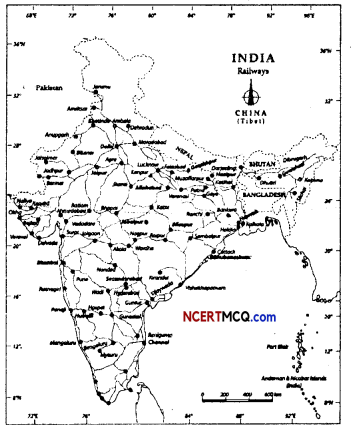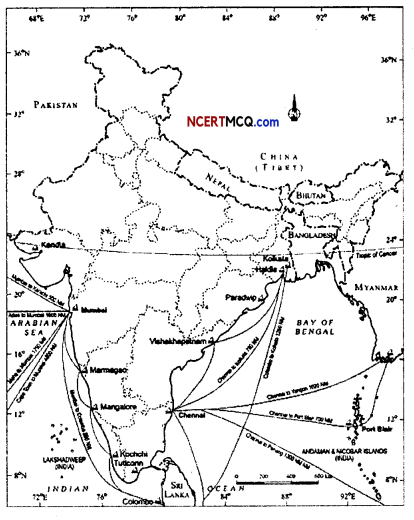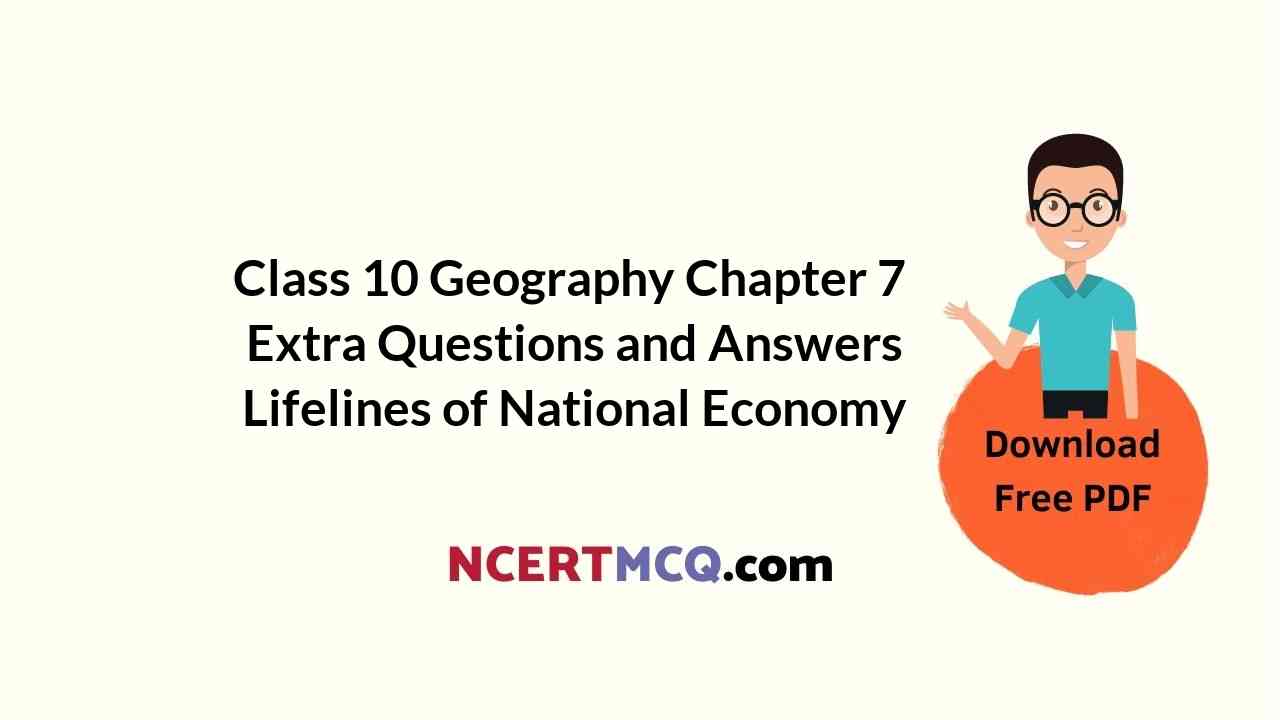Check the below NCERT MCQ Questions for Class 10 Geography Chapter 7 Extra Questions and Answers Lifelines of National Economy with Answers Pdf free download. https://ncertmcq.com/extra-questions-for-class-10-social-science/
Lifelines of National Economy Class 10 Extra Questions Geography Chapter 7
Lifelines Of National Economy Class 10 Extra Questions And Answers Question 1.
How many foreign tourists visit India per year?
Answer:
About 2.6 million.
Class 10 Geography Chapter 7 Extra Questions Question 2.
How much rupees were earned by India in the year 2004?
Answer:
About 21828 crore.
Lifelines Of National Economy Extra Questions Question 3.
What was the part constituted by import in India’s foreign trade in 2000-01?
Answer:
About 53%.
Extra Questions For Class 10 Geography Chapter 7 Question 4.
What is the length of India’s coastline?
Answer:
75166 km.
Lifelines Of National Economy Class 10 Important Questions And Answers Question 5.
How many ports are there in India?
Answer:
India has 12 major and 181 medium and minor seaports.
Chapter 7 Sst Class 10 Geography Question 6.
How many radio stations are there in India?
Answer:
200.
![]()
Chapter 7 Geography Class 10 Important Questions Question 7.
How many telephone exchanges are there in India?
Answer:
About 37565.
Extra Questions Of Chapter Lifelines Of National Economy Question 8.
What is the length of Champakara canal?
Answer:
14 km.
Class 10 Geography Lifelines Of National Economy Important Questions Question 9.
Which of the national waterways is the smallest one?
Answer:
The Champakara canal.
Extra Questions Of Lifelines Of National Economy Question 10.
When was the air transport nationalised?
Answer:
In 1953.
Lifelines Of National Economy Important Questions Question 11.
Point out the significance of the unsurfaced roads in India.
Answer:
The significance of the unsurfaced roads in India are the following-
- The unsurfaced roads are easy to construct and easy to maintain.
- They can even be made to pass easily through forests and deserts and mountains.
- These are of great importance, especially in rural areas.
- They connect different villages easily.
- These roads also connect villages with national highways.
Class 10 Sst Extra Questions Question 12.
What is the importance of road transport as a means of transport?
Answer:
The importance of road transport as a means of transport are the following-
- This means of transport is comparatively more flexible.
- With the help of it, the goods can be carried out from the very doors of the seller to those of the buyers.
- In the hilly area road transport assures a great importance of its own.
- Roads are comparatively easy to construct and also easy to maintain.
- This transport provides link to railways also.
- The roads can also be conducted to connect even the remotest of villages with the national highways or other important places.
Social Science Class 10 Extra Questions Question 13.
Write down the importance of air transport.
Or
Air transport is getting more and more important these days. Give points.
Or ‘
Why is the air transport getting more and more importance these days?
Answer:
The importance of air transport in present context is getting more and more important because of the following reasons:
- Air travel is the faster means of transport.
- It saves a lot of time and energy.
- It facilitates business transactions and bring administrative efficiency.
- It makes accessibility possible in the remotest areas also.
- Air transport fulfils the needs of every type ranging from military to the civilian.
![]()
Important Questions Of Lifelines Of National Economy Class 10 Question 14.
Point out the major changes in the development of the Indian railway since independence.
Or
Why are the means of transport and communication the lifelines of a nation and its economy?
Or
What do you understand by the lifeline of our country?
Or
Write down in you own words the importance of transport and communication.
Answer:
In today’s modern world the means of transport and communication have no doubt turned as the lifelines of a country and also of its economy. The various forms of transport that are used to carry passengers and goods from one place to another are called the means of transport. On the other hand, communication means sending messages from one place to another.
These are known as the ‘Lifelines’ of a country because of the following reasons-
- They bring the far-flung areas of a country quite closer to each other.
- They carry the greatest number of passengers in longest journeys in lesser time but with greater comforts.
- They carry thousands of tonnes of different commodities from one part of the country to the other and thus avoid much hardships to the people.
- Also in the war times, their importance can hardly be emphasized. They bring the whole country at the back of the armed forces and facilitate the movement of arms, ammunition and other supplies.
- These means of communication and transport also help the Government to maintain law and order.
- These various means have also forged the bonds of national unity in our country by promoting social and cultural contacts between the various people of the country.
Ncert Extra Questions Class 10 Social Science Question 15.
Giving the various examples from the different parts of India, compare and contrast roads and railways as a means of transport.
Or
Transport is the prerequisite for modem industry. Explain.
Or
Does the road transport score over the railway’s transport?
Answer:
In the today’s modern industrial age, roads and railways, as means of transport, have great importance. They are in fact just like the lifelines of modern industries and in modern economy. In fact, both of these means of transport are interdependent on each other and can help each other in numberous ways. For example, the trucks can take the raw materials from the railway stations. The railway can carry these heavy goods to long distances and then trucks can take these materials to the different markets.
Though both the railways and roads are necessary for the development of the modern industries yet the road transport has acquired great importance of its own. It has in fact the following facts in its support- Roads are of considerable significance for passengers and goods traffic in India. Roads are relatively easy to construct and also to maintain.
The investment in roadways is also much less than that of in the railways. The most significant fact about the roads and the road traffic is that they can negotiate high radiant and can be brought almost to our doorsteps, unlike the railways. The road transport is faster than railway transport. Loading, unloading and transhipment from one gauge to another is easily facilitated by the road transports.
Road transport is easier and trans-shipment from one gauge to another is easily facilitated by the road transports.
Road transport is easier and also easier for private use. Trucks or buses can be hired at any time and for any place.
Inspite of all the above factors, as the means of transport both the railways and the roadways are needed for the full development of the industries in our country because they have their own specific uses. As a matter of fact in our country long-distance routes in India are connected by railways whereas shorter distances are connected by road. Hence facilitating each other. So we must pay attention to the development of both of the transport means.
Multiple Choice Questions
Question 1.
International trade is carried between:
(a) Two and more cities
(b) Two and more towns
(c) Two and more provinces
(d) Two and more countries.
Answer:
(d) Two and more countries.
![]()
Question 2.
The air transport was nationalised in:
(a) 1953
(b) 1954
(c) 1955
(d) 1956
Answer:
(a) 1953
Question 3.
Haldia port was developed to help relieve the growing pressure of the following:
(a) Mumbai port
(b) Chennai port
(c) Kolkata port
(d) None of these
Answer:
(c) Kolkata port
Question 4.
The Ganga waterways between Allahabad and Haldia is:
(a) 891 km
(b) 1620 km
(c) 168 km
(d) None of these
Answer:
(b) 1620 km
Map Skills
Question 1.
On the outline map of India, show the following:
(i) National Highways
(ii) Railways ‘
(iii) Major sea routes, ports, International Airports.
(iv) None of these
(v) Map No. 1.
Answer:



